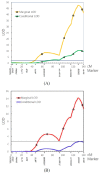A Major Locus for Quantitatively Measured Shank Skin Color Traits in Korean Native Chicken
- PMID: 27383802
- PMCID: PMC5088374
- DOI: 10.5713/ajas.16.0183
A Major Locus for Quantitatively Measured Shank Skin Color Traits in Korean Native Chicken
Abstract
Shank skin color of Korean native chicken (KNC) shows large color variations. It varies from white, yellow, green, bluish or grey to black, whilst in the majority of European breeds the shanks are typically yellow-colored. Three shank skin color-related traits (i.e., lightness [L*], redness [a*], and yellowness [b*]) were measured by a spectrophotometer in 585 progeny from 68 nuclear families in the KNC resource population. We performed genome scan linkage analysis to identify loci that affect quantitatively measured shank skin color traits in KNC. All these birds were genotyped with 167 DNA markers located throughout the 26 autosomes. The SOLAR program was used to conduct multipoint variance-component quantitative trait locus (QTL) analyses. We detected a major QTL that affects b* value (logarithm of odds [LOD] = 47.5, p = 1.60×10-49) on GGA24 (GGA for Gallus gallus). At the same location, we also detected a QTL that influences a* value (LOD = 14.2, p = 6.14×10-16). Additionally, beta-carotene dioxygenase 2 (BCDO2), the obvious positional candidate gene under the linkage peaks on GGA24, was investigated by the two association tests: i.e., measured genotype association (MGA) and quantitative transmission disequilibrium test (QTDT). Significant associations were detected between BCDO2 g.9367 A>C and a* (PMGA = 1.69×10-28; PQTDT = 2.40×10-25). The strongest associations were between BCDO2 g.9367 A>C and b* (PMGA = 3.56×10-66; PQTDT = 1.68×10-65). However, linkage analyses conditional on the single nucleotide polymorphism indicated that other functional variants should exist. Taken together, we demonstrate for the first time the linkage and association between the BCDO2 locus on GGA24 and quantitatively measured shank skin color traits in KNC.
Keywords: BCDO2; Korean Native Chicken; Linkage and Association; Quantitative Trait Locus; Shank Skin Color.
Figures


Similar articles
-
Variance Component Quantitative Trait Locus Analysis for Body Weight Traits in Purebred Korean Native Chicken.Asian-Australas J Anim Sci. 2016 Jan;29(1):43-50. doi: 10.5713/ajas.15.0193. Asian-Australas J Anim Sci. 2016. PMID: 26732327 Free PMC article.
-
Genome scan linkage analysis identifies quantitative trait loci affecting serum clinical-chemical traits in Korean native chicken.Mol Biol Rep. 2016 Jul;43(7):601-5. doi: 10.1007/s11033-016-3994-y. Epub 2016 May 17. Mol Biol Rep. 2016. PMID: 27188424
-
Identification of quantitative trait loci for the fatty acid composition in Korean native chicken.Asian-Australas J Anim Sci. 2018 Aug;31(8):1134-1140. doi: 10.5713/ajas.17.0781. Epub 2018 Jan 26. Asian-Australas J Anim Sci. 2018. PMID: 29381899 Free PMC article.
-
Detection of QTL for traits related to adaptation to sub-optimal climatic conditions in chickens.Genet Sel Evol. 2017 Apr 20;49(1):39. doi: 10.1186/s12711-017-0314-5. Genet Sel Evol. 2017. PMID: 28427323 Free PMC article.
-
Identification of QTL controlling meat quality traits in an F2 cross between two chicken lines selected for either low or high growth rate.BMC Genomics. 2007 Jun 8;8:155. doi: 10.1186/1471-2164-8-155. BMC Genomics. 2007. PMID: 17559654 Free PMC article.
Cited by
-
Association of single-nucleotide polymorphisms in dual specificity phosphatase 8 and insulin-like growth factor 2 genes with inosine-5'-monophosphate, inosine, and hypoxanthine contents in chickens.Anim Biosci. 2023 Sep;36(9):1357-1366. doi: 10.5713/ab.23.0080. Epub 2023 Jun 23. Anim Biosci. 2023. PMID: 37402464 Free PMC article.
-
Unique insights into morphological characterization and functional adaptation of the scaly shank skin in aquatic and terrestrial birds.Sci Rep. 2024 Nov 15;14(1):28101. doi: 10.1038/s41598-024-77650-w. Sci Rep. 2024. PMID: 39543198 Free PMC article.
-
Genetic and metabolic factors influencing skin yellowness in yellow-feathered broilers.Poult Sci. 2025 Jan;104(1):104534. doi: 10.1016/j.psj.2024.104534. Epub 2024 Nov 8. Poult Sci. 2025. PMID: 39561557 Free PMC article.
-
Genomic and transcriptomic analyses unveil the genetic basis of green shank trait in small white-feather chickens.Poult Sci. 2025 Apr;104(4):104912. doi: 10.1016/j.psj.2025.104912. Epub 2025 Feb 17. Poult Sci. 2025. PMID: 39985900 Free PMC article.
-
Uganda chicken genetic resources: I. phenotypic and production characteristics.Front Genet. 2023 Jan 24;13:1033031. doi: 10.3389/fgene.2022.1033031. eCollection 2022. Front Genet. 2023. PMID: 36761692 Free PMC article.
References
LinkOut - more resources
Full Text Sources
Other Literature Sources

